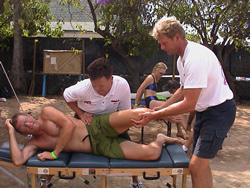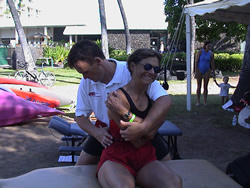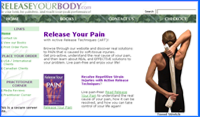|
How can ART improve my running?
|
Read Dr. Abelson Blog on Running

|
Running Injuries and Repetitive
Motion
Running injuries are commonly attributed to faulty
biomechanics and errors in training methods.
Faulty training techniques include:
- The rapid build up of mileage
- Running on worn-out shoes
- Ignoring our body's messages and continuing
to run through pain.
Although these important aspects of a running program
should be addressed, runners should also consider the cumulative
effect that thousand of repetitive motions
have on their bodies.
Even with good biomechanics and excellent training,
runners are always exposed to a considerable amount of cumulative
trauma. As a marathon runner myself, and as a triathletes for
over 20 years, I have felt the effects of cumulative stress injuries
caused by running.
Like many runners I sometimes push myself over my
limits and then pay the price with either an injury or inflammation
of soft tissues.
These injuries can be debilitating and result in reduced
ability to conduct any physical activities. Traditional treatment
techniques often require months to fully resolve injuries to soft
tissue.
In this page:
|
| About Soft
Tissue Injuries |
 |
Injuries to soft tissue (ligaments, muscles, blood vessels,
fascia and nerves) result in inflammation and swelling of the tissue.
The body responds to this inflammation by laying down scar tissue (cross
fibers on the tissue) in an attempt to stabilize the affected area.
This scar tissue restricts motion, reduces circulation,
inhibits nerve function, and causes ongoing friction and pressure, and
usually results in the production of more cross fibers and adhesions.
Effective treatment of soft tissue injuries requires an alteration in
tissue structure by breaking up cross-fiber adhesions and restoring normal
function to the soft tissue. This process substantially decreases healing
time, treats the root cause of the injury, and improves running performance.
| How ART Works
with Running Injuries |
 |
Active Release Technique is the most effective form
of therapy I have seen or used for the treatment of soft tissue injuries
and for the improvement of running performance.
Its effects are immediate, often dramatic, and always reassuring.
ART lets the runner return to his/her running quickly, minimizes or removes
the result of repetitive stress injuries, and results in a freer, more
easy run by removing adhesions and cross fibers that restrict normal movement.
During the ART procedure, the Doctor formulates his diagnosis
and performs the treatment at the same time. Practitioners must consider
tissue texture, tissue tension, tissue movement, and tissue function.
Each of these factors can cause the doctor to greatly alter the required
treatment.
For example, take the case of a Sciatic nerve that is entrapped
between the hamstrings. In such cases, the patient's symptoms are often
exacerbated during hip flexion with extension of the knee and dorsiflexion
of the ankle. The ART Practitioner can also feel the lack of motion in
areas that are entrapped, by the lack of tissue translation.
Once your Doctor has identified the specific entrapment
site, and has the lesion (scar tissue/adhesion) under specific contact
with his/her hand, the Doctor takes the tissue from a shortened to a fully
elongated position, while moving longitudinally along the soft tissue
fibers.
See the following topics for more information about ART:
| What Happens After
an ART Treatment |
 |
Rehabilitation remains an important part of the ART procedure.
After the ART procedures, we have the patients:
- Ice, stretch, and strengthen the feet to prevent re-occurrences.
We also have them
- Test our treatments by returning to their running program.
This is what we call dialing in the body.
- Validate the effectiveness of the treatment by
checking the ability of the patient to complete the task that caused
the injury.
| How Effective
is ART for Treating Running Injuries |
 |
In my practice, working with a broad range of soft tissue
injuries, I have discovered that Active
Release Technique (ART) to be most effective method for breaking the
restrictions formed by running.
|

Dr. Abelson and Dr. Battershill treating a triathelete
for hip restrictions in Kona, for the 2001 Ironman Triathalon.

Dr. Abelson treating a triathelete for rotational
restrictions in Kona, for the 2001 Ironman Triathalon.
|
The effectiveness of ART was seen during the 2001
World Championship Ironman Triathlon in Kona, Hawaii.
The ART team at Kona treated more than 1000 athletes
prior to the event. ART practitioners worked with a broad range
of injuries related to running, swimming and cycling.
This Ironman faced some of worst course conditions
ever seen at Kona. Cyclists were literally blown off their bikes
due to the high winds. Temperatures were high, and the sun hot!
Despite brutal conditions, this race had the largest
number of finishing competitors in the history of Ironman.
Ironman race directors attribute this high level of
race completion directly to the Active Release Technique treatments
received by athletes prior to the event.
|
Where can I find more information
about ART?
We have recently published the first book about Active Release
Techniques, written specifically for the general public.
|
Release Your Pain - Resolving Repetitive
Strain Injuries with Active Release Techniques® (ART®)
is an informative, easy-to-read book, that helps you to understand
the true cause of repetitive strain injuries.
Did you know that many common therapies
(such as medication, physiotherapy, chiropractic treatment, massage,
electrical muscle stimulation, rest, exercise, and surgery) have
all failed to effectively resolve repetitive strain injuries. RSI
sufferers are rarely able to find effective or complete treatment
with these traditional treatments! Read Release
Your Pain now to understand why these treatments often fail
to solve your problem.
|
Common types of Running Injuries Treated with ART
- Knee injuies
- Foot injury
- Hip injuries ,
- Ankle
- Calf injury
- Groin injuries
- Hamstring
- Shoulder injuries
- Back Injuries
| Read an information
article about Running! |
|
| Read this article.... |
For information about... |
| Improve
Your Running with Active Release Technique |
How running injuries can be quickly
identified and resolved using the ART methodology.
|
| Running
Injuries |
How to increase your running performance
and resolve common running injuries...quickly...so that you can return
to peak performance capabilities.
|
| Improve
Your Athletic Performance with Active Release Technique |
How ART was used to at the Ironman
Triathlon Championships in Penticton and Kona, Hawaii to help resolve
athletic injuries, improve performance, and assist athletes in completing
these tremendously difficult events.
|
| Plantar
Fasciatis |
Getting rid of that pain
in your foot! |
| Repetitive
Strain Injuries |
How repetitive strain
injuries occur, and what ART can do help resolve these injuries. ART
has been proven to be 90% effective in the resolution of conditions
such as Carpel Tunnel Syndrome....WITHOUT surgery! |
| ART
and Sciatica |
What is the real cause of Sciatica,
and how Dr. Abelson experienced an amazing release from pain by applying
the ART technique to his sciatica problem.
|

Click the link above to go to the running page at www.drableson.com

Click the image for information about Dr. Abelson's publications.
|



